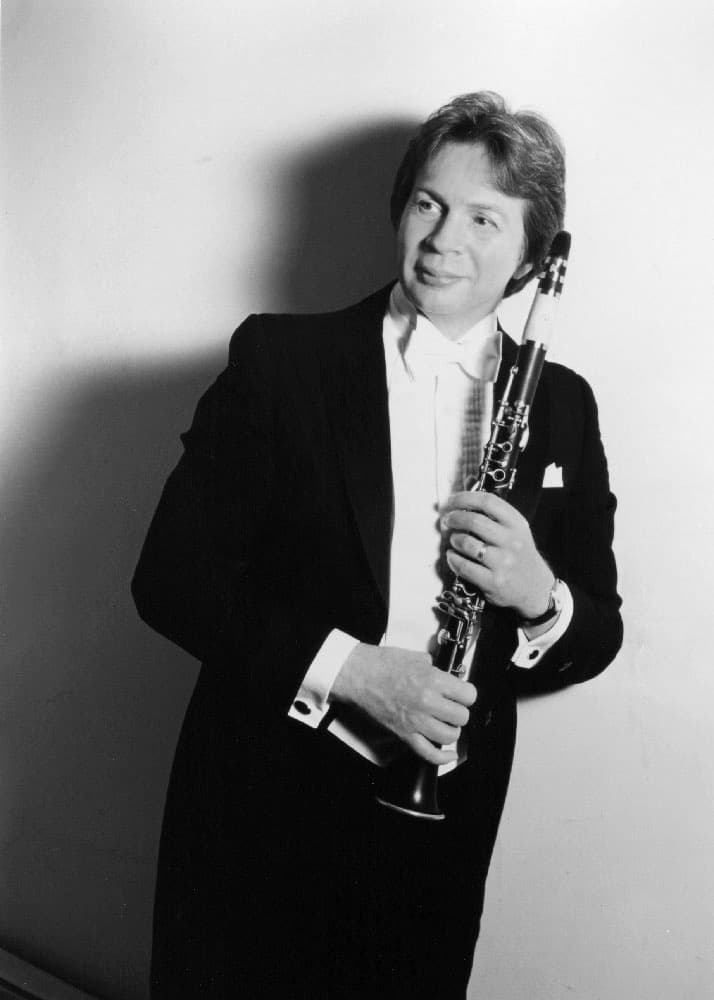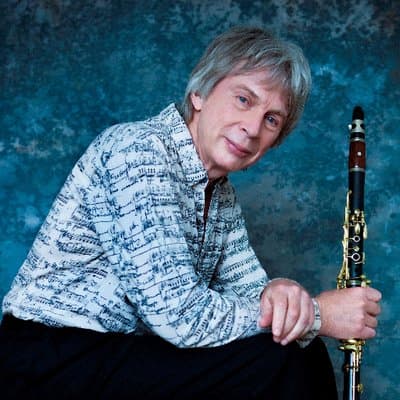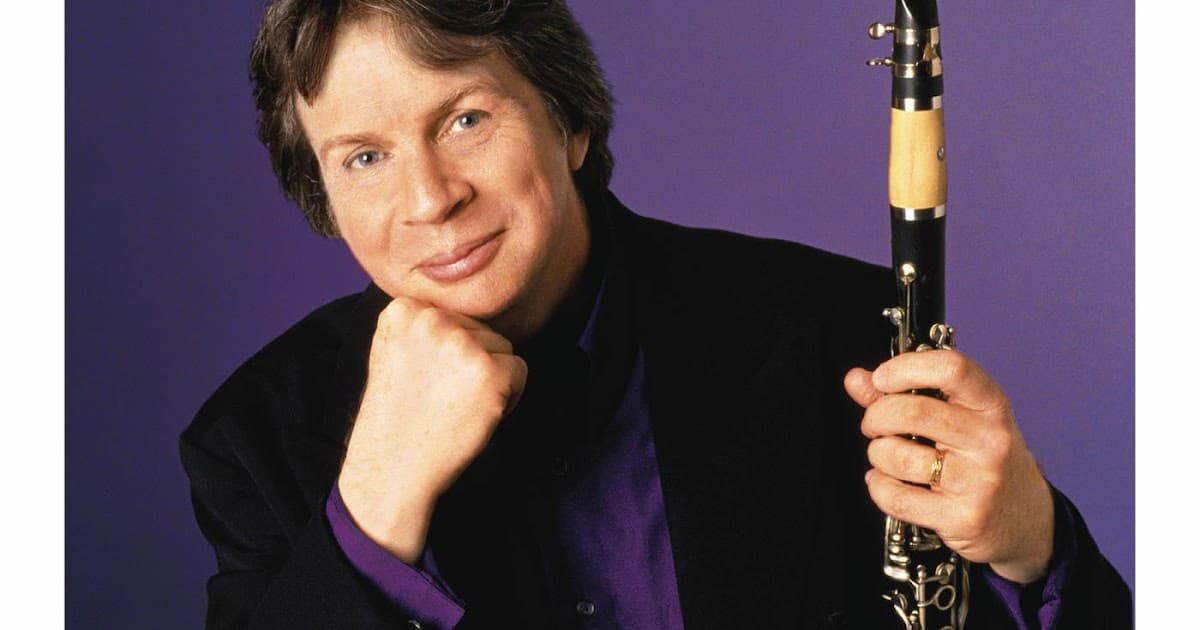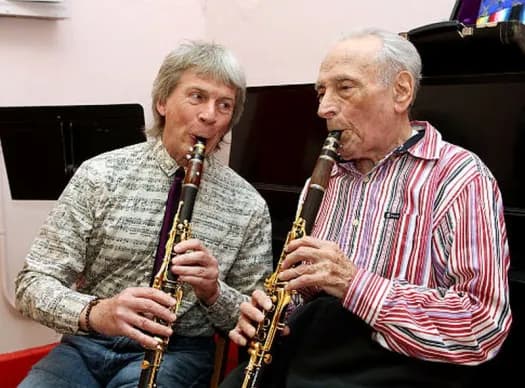The American clarinettist Richard Stoltzman is known for his freely expressive style and individuality of phrasing and interpretation. A two-time Grammy Award Winner, Stoltzman is a captivating recitalist, chamber musician, and jazz performer, as well as a prolific recording artist. In 1986, he was the first wind player to be awarded the Avery Fisher Prize, and he delivered the first clarinet recital in the history of both the Hollywood Bowl and Carnegie Hall. Stoltzman has performed with more than a hundred orchestras, and in 2013, he was elected a Fellow of the American Academy of Arts and Sciences.
Richard Stoltzman Performs “Goodbye” (In Memory of Benny)
Railroad Family

The young Richard Stoltzman
Richard Leslie Stoltzman was born on 12 July 1942 in Omaha, Nebraska, to Leslie Harvey Stoltzman and Dorothy Marilyn Spohn. Stoltzman’s father was a railroad man working for the Western Pacific Railroad. Soon after Richard’s birth, the family moved to San Francisco, and his first exposure to music came through his father’s interest in big band music. The radio was always tuned to big band music, and his father played saxophone in a dance band during his spare time.
Around the age of seven, Richard found “these wonderful cylindrical objects in a nice leather case. I enjoyed playing with them, and I even remember dangling them from the second-story window of our house. That caused quite a stir because they turned out to be my father’s clarinets. But instead of punishing me, he decided that I had an interest in the instrument and rented an indestructible metal clarinet for me to start on.”
Wolfgang Amadeus Mozart: Clarinet Quintet in A Major, K. 581 (Richard Stoltzman, clarinet; Tokyo String Quartet)
First Contact

Richard Stoltzman
Stoltzman began formal clarinet lessons at the age of eight at his local school, and he soon played with his father at their church and at community functions. He continued to experiment with the instrument during his high school days in Cincinnati, and he developed jazz improvisation techniques. According to Stoltzman, Benny Goodman was “his earliest musical mentor, and he remained a strong influence throughout his career.”
Stoltzman had high ambitions, and he applied for music scholarships at the Eastman School of Music in Rochester, New York, and the Juilliard School in New York City. Sadly, both applications were rejected. Undeterred, Stoltzman entered Ohio State University in 1960 and majored in mathematics and music. His first real exposure to classical music took place during his university studies when someone gave him a ticket to a concert by the Juilliard Quartet.
Alban Berg: 4 Stücke, Op. 5 (Richard Stoltzman, clarinet; Peter Serkin, piano)
Discovery

As Stoltzman told Symphony Magazine, “they played the Lyric Suite by Alban Berg, and I was so knocked out. I didn’t know there was music like that … played with such intensity and precision and emotion. That’s when I realized that it wasn’t enough to play jazz or just enjoy music. You had to give blood.” Stoltzman had contemplated a career in dentistry, but after a couple of lessons with Robert Marcellus, clarinettist with the Cleveland Orchestra, he decided to pursue graduate studies in music instead.
Stoltzman entered Yale School of Music in 1964 on a graduate scholarship in music and studied with Professor Keith Wilson. His formal introduction to chamber music was hearing the Brahms clarinet quintet, and by the time he graduated with a Master of Music degree, he was fire and flame about classical music. As he explained in an interview, “not only did I come to feel that music was essential to life, but I was surrounded by people who tried to play like a voice singing.”
Johannes Brahms: Clarinet Quintet in B Minor, Op. 115 (Richard Stoltzman, clarinet; Cleveland Quartet)
Difficult Path

Richard Stoltzman and Kalmen Opperman
Stoltzman was highly interested in expanding and broadening the range of timbre and tonal colours available to the clarinet, and he attempted to draw the instrument closer to the sonorities of string instruments. When he auditioned twice for the Marlboro Music Festival in Vermont during his time at Yale, he was turned down both times. As such, he went on to work towards a doctoral degree at Columbia University, working with the eminent clarinet pedagogue Kalmen Opperman.
Opperman quickly pointed out a number of shortcomings in Stoltzman’s clarinet playing. As he recalls, “one of the first things he told me was that I moved my fingers like a country bumpkin.” In the event, with renewed confidence, Stoltzman auditioned again for the Marlboro Music Festival and was accepted. He stayed with the festival for ten years and studied with world-class artists such as Rudolf Serkin and Pablo Casals. One evening, after a performance, Casals called him over to his chair and said, “You are an artist.”
For more of the best in classical music, sign up for our E-Newsletter
